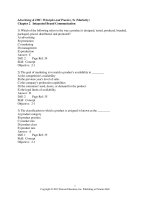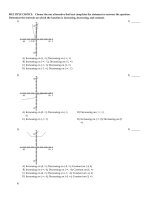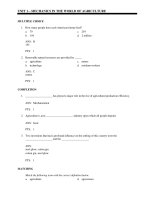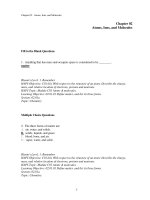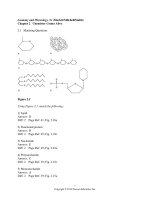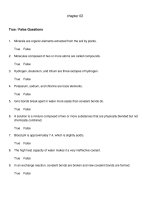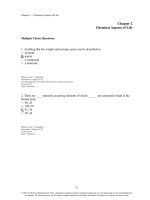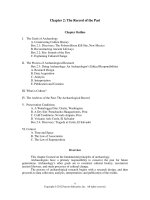Algebra and trigonometry graphs and models 5th edition bittinger test bank
Bạn đang xem bản rút gọn của tài liệu. Xem và tải ngay bản đầy đủ của tài liệu tại đây (2.45 MB, 49 trang )
MULTIPLE CHOICE. Choose the one alternative that best completes the statement or answers the question.
Determine the intervals on which the function is increasing, decreasing, and constant.
1)
1) _______
A)
B)
C)
D)
Increasing on (1, ∞); Decreasing on (-∞, 1)
Increasing on (-∞, -1); Decreasing on (-1, ∞)
Increasing on (-∞, 1); Decreasing on (1, ∞)
Increasing on (-1, ∞); Decreasing on (-∞, -1)
2)
2) _______
A) Increasing on (0, ∞); Decreasing on (-∞,
0)
C) Increasing on (-∞, ∞)
B) Decreasing on (-∞, ∞)
D) Increasing on (-∞, 0); Decreasing on (0,
∞)
3)
3) _______
A)
B)
C)
D)
4)
Increasing on (4, ∞); Decreasing on (-4, ∞); Constant on (-4, 4)
Increasing on (-∞, 4); Decreasing on (-∞, -4); Constant on (4, ∞)
Increasing on (4, ∞); Decreasing on (-∞, -4); Constant on (-4, 4)
Increasing on (-∞, 4); Decreasing on (-4, ∞); Constant on (4, ∞)
4)
__
__
__
_
A) Increasing on (1, 3); Decreasing on (-2, 0) and (3, 5); Constant on (2, 5)
B) Increasing on (-2, 0) and (3, 5); Decreasing on (1, 3); Constant on
C) Increasing on (-2, 0) and (3, 4); Decreasing on (-5, -2) and (1, 3)
D) Increasing on (-1, 0) and (3, 5); Decreasing on (0, 3); Constant on (-5, -3)
5)
5) _______
A)
B)
C)
D)
Increasing on (-5, -3) and (2, 5); Decreasing on (-3, 0); Constant on (0, 2)
Increasing on (-3, -1); Decreasing on (-5, -2) and (2, 4); Constant on (-1, 2)
Increasing on (-3, 0); Decreasing on (-5, -3) and (2, 5); Constant on (0, 2)
Increasing on (-3, 1); Decreasing on (-5, -3) and (0, 5); Constant on (1, 2)
Determine the domain and range of the function.
6)
A) domain: [-3, 0]; range: [-3, 1]
C) domain: [0, 3]; range: (-∞, 1]
7)
6) _______
B) domain: (-∞, 1]; range: [0, 3]
D) domain: [-3, 1]; range: [-3, 0]
7)
__
__
__
_
A)
B)
C)
D)
domain: (-∞, ∞); range: (-∞, 1]
domain: (-∞, -5) ∪ (-5, ∞); range: (-∞, 1) ∪ (1, ∞)
domain: (-∞, -5]; range: (-∞, 1]
domain: (-∞, ∞); range: (-∞, ∞)
8)
8) _______
A) domain: [0, ∞); range: (-∞, ∞)
C) domain: [0, ∞); range: [-1, ∞)
B) domain: [0, ∞); range: [0, ∞)
D) domain: (-∞, ∞); range: [-1, ∞)
9)
9) _______
A) domain: (-3, 3]; range: (-∞, ∞)
C) domain: (-∞, ∞); range: [-3, 3)
10)
B) domain: (-∞, ∞); range: [-3, 3]
D) domain: (-∞, ∞); range: (-3, 3]
10)
A) domain: [0, 4]; range: (-∞, ∞)
C) domain: (-∞, ∞); range: [0, 4]
___
___
B) domain: (-∞, ∞); range: (0, 4)
D) domain: (0, 4); range: (-∞, ∞)
11)
11) ______
A) domain: [-2, 2]; range: [-2, ∞)
C) domain: [-2, ∞); range: [-2, 2]
B) domain: [-2, ∞); range: [-2, ∞)
D) domain: (-2, ∞); range: (-2, ∞)
12)
12) ______
A) domain: [0, 12]; range: [1, 6]
C) domain: [1, 6]; range: [0, 12]
B) domain: (1, 6); range: (0, 12)
D) domain: (0, 12); range: (1, 6)
Using the graph, determine any relative maxima or minima of the function and the intervals on which the function is
increasing or decreasing. Round to three decimal places when necessary.
13) f(x) =
- 6x + 7
13)
A)
B)
C)
D)
___
___
relative minimum: 3 at y = -2; increasing (-∞, 3); decreasing (3, ∞)
relative maximum: -2 at x = 3; increasing (3, ∞); decreasing (-∞, 3)
relative maximum: 3 at y = -2; increasing (-∞, 3); decreasing (3, ∞)
relative minimum: -2 at x = 3; increasing (3, ∞); decreasing (-∞, 3)
14) f(x) = x3 - 3x2 + 1
A) relative maximum: 1 at x = 0; no relative minima; increasing
B) relative maximum: 1 at x = 0; relative minimum: -3 at x = 2; increasing
decreasing
C) no relative maxima; relative minimum: -3 at x = 2; increasing
D) relative maximum: -3 at x = 2; relative minimum: 1 at x = 0; increasing (0, 2); decreasing
15) f(x) = x3 - 12x + 2
14) ______
15)
___
___
A) relative maxima: 18 at x = -2 and 0 at x = 0; relative minimum: -14 at x = 2; increasing
decreasing
B) relative maximum: 18 at x = -2; relative minimum: -14 at x = 2; increasing
decreasing
C) no relative maxima or minima; increasing
decreasing
D) relative maximum: -14 at x = 2; relative minimum: 18 at x = -2; increasing
;
decreasing
16)
16) ______
f(x) =
+
-x+1
A) no relative maxima or minima; increasing
decreasing
B) relative maximum: 2.056 at x = -1.215; relative minima: 0.684 at x = 0.549 and 1 at x = 0;
increasing
decreasing
C) relative maximum: 2.056 at x = -1.215; relative minimum: 0.684 at x = 0.549; increasing
decreasing
D) relative maximum: 0.684 at x = 0.549; relative minimum: 2.056 at x = -1.215; increasing
decreasing
17) f(x) = -0.06
- 0.3
+ 0.1x + 3
17)
___
___
A) relative maximum: 1.547 at x = -3.492; relative minimum: 3.008 at x = 0.159; increasing
decreasing
B) no relative maxima or minima; increasing
decreasing
C) relative maximum: 3.008 at x = 0.159; relative minimum: 1.547 at x = -3.492; increasing
decreasing
D) relative maxima: 3 at x = 0 and 3.008 at x = 0.159; relative minimum: 1.547 at x = -3.492;
increasing
decreasing
Graph the function. Use the graph to find any relative maxima or minima.
18) f(x) =
-2
A) Relative minimum of - 2 at x = 0
C) Relative maximum of - 2 at x = 0
19) f(x) = -
+3
B) Relative minimum of - 2 at x = 1
D) No relative extrema
18) ______
19)
A)
B)
C)
D)
___
___
No relative extrema
Relative minimum of 3 at x = 0
Relative maximum of 3 at x = 0
Relative maximum of 3 at x = 0 and relative minimum at x = 3
20) f(x) = -
A) Relative minimum of 1 at x = 3
C) Relative maximum of 3 at x = 1
21) f(x) =
20) ______
+ 6x - 8
B) No relative extrema
D) Relative maximum of 1 at x = 3
21) ______
+ 8x + 13
A) Relative minimum of - 3 at x = - 4
C) Relative maximum of - 3 at x = - 4
B) Relative maximum of - 3.2 at x = - 4.1
D) Relative minimum of - 3.2 at x = - 4.1
22) f(x) = 1 - |x|
A) No relative extrema
C) Relative minimum of 1 at x = 0
22) ______
B) Relative maximum of 1 at x = 0
D) Relative maximum of 1.5 at x = 0
23) f(x) = |x + 3| - 4
A) Relative minimum of - 4 at x = - 3
C) Relative maximum of 4 at x = - 3
23) ______
B) Relative minimum of 3.7 at x = - 3
D) Relative minimum of 4.2 at x = - 3
Solve.
24) Elissa wants to set up a rectangular dog run in her backyard. She has 20 feet of fencing to work
with and wants to use it all. If the dog run is to be x feet long, express the area of the dog run as a
function of x.
A) A(x) = 12 - x
B) A(x) = 9x C) A(x) = 11x D) A(x) = 10x -
24) ______
25) Bob wants to fence in a rectangular garden in his yard. He has 72 feet of fencing to work with
and wants to use it all. If the garden is to be x feet wide, express the area of the garden as a
function of x.
A) A(x) = 35x B) A(x) = 36x C) A(x) = 38 - x
D) A(x) = 37x -
25) ______
26) A rocket is shot straight up in the air from the ground at a rate of 67 feet per second. The rocket
is tracked by a rangefinder that is 426 feet from the launch pad. Let d represent the distance from
the rocket to the rangefinder and t represent the time, in seconds, since "blastoff". Express d as a
function of t.
A)
B)
d(t) =
d(t) =
C) d(t) =
D)
+
d(t) = 426 + 67
26) ______
27) Sue wants to put a rectangular garden on her property using 62 meters of fencing. There is a
river that runs through her property so she decides to increase the size of the garden by using
the river as one side of the rectangle. (Fencing is then needed only on the other three sides.) Let x
represent the length of the side of the rectangle along the river. Express the garden's area as a
function of x.
A) A(x) = 32x - 2
B)
27) ______
A(x) = 30x C) A(x) = 31
D)
-x
A(x) = 31x 28) A farmer's silo is the shape of a cylinder with a hemisphere as the roof. If the height of the silo is
115 feet and the radius of the hemisphere is r feet, express the volume of the silo as a function of
r.
A)
B)
V(r) = π(115 - r)
+
V(r) = π(115 - r) +
π
C)
28) ______
π
D)
V(r) = π(115 - r)
+
V(r) = 115π
π
+
π
29) A farmer's silo is the shape of a cylinder with a hemisphere as the roof. If the radius of the
hemisphere is 10 feet and the height of the silo is h feet, express the volume of the silo as a
function of h.
A)
B)
V(h) = 100 πh +
V(h) = 100 π(h - 10) +
π
C)
29) ______
π
D)
V(h) = 4100 π(h - 10) +
V(h) = 100 π(
π
- 10) +
π
30) A rectangular sign is being designed so that the length of its base, in feet, is 10 feet less than 4
times the height, h. Express the area of the sign as a function of h.
A) A(h) = 10h - 2
B) A(h) = -10h + 4
C) A(h) = -10
+ 2h
D) A(h) = -10h +
31) From a 40-inch by 40-inch piece of metal, squares are cut out of the four corners so that the sides
can then be folded up to make a box. Let x represent the length of the sides of the squares, in
inches, that are cut out. Express the volume of the box as a function of x.
A) V(x) = 2
B) V(x) = 4
- 120 + 40x
- 160 + 1600x
C) V(x) = 4
- 160
D) V(x) = 2
C(x) = 2
+
31) ______
- 120
32) A rectangular box with volume 469 cubic feet is built with a square base and top. The cost is
$1.50 per square foot for the top and the bottom and $2.00 per square foot for the sides. Let x
represent the length of a side of the base. Express the cost the box as a function of x.
A)
B)
C)
30) ______
C(x) = 3
+
C(x) = 3
+
32) ______
D)
C(x) = 4x +
33) A rectangle that is x feet wide is inscribed in a circle of radius 34 feet. Express the area of the
rectangle as a function of x.
A) A(x) = x(4624 - )
B) A(x) = x
33) ______
C)
A(x) =
D)
A(x) = x
34) From a 15-inch by 15-inch piece of metal, squares are cut out of the four corners so that the sides
can then be folded up to make a box. Let x represent the length of the sides of the squares, in
inches, that are cut out. Express the volume of the box as a function of x. Graph the function and
from the graph determine the value of x, to the nearest tenth of an inch, that will yield the
maximum volume.
A) 2.8 inches
B) 3.1 inches
C) 2.5 inches
D) 2.3 inches
34) ______
35) From a 24-inch by 24-inch piece of metal, squares are cut out of the four corners so that the sides
can then be folded up to make a box. Let x represent the length of the sides of the squares, in
inches, that are cut out. Express the volume of the box as a function of x. Graph the function and
from the graph determine the value of x, to the nearest tenth of an inch, that will yield the
maximum volume.
A) 3.7 inches
B) 4.1 inches
C) 4.0 inches
D) 3.8 inches
35) ______
36) A rectangular box with volume 468 cubic feet is built with a square base and top. The cost is
$1.50 per square foot for the top and the bottom and $2.00 per square foot for the sides. Let x
represent the length of a side of the base in feet. Express the cost of the box as a function of x and
then graph this function. From the graph find the value of x, to the nearest hundredth of a foot,
which will minimize the cost of the box.
A) 8.55 feet
B) 8.63 feet
C) 7.92 feet
D) 8.44 feet
36) ______
37) A rectangular box with volume 517 cubic feet is built with a square base and top. The cost is
$1.50 per square foot for the top and the bottom and $2.00 per square foot for the sides. Let x
represent the length of a side of the base in feet. Express the cost of the box as a function of x and
then graph this function. From the graph find the value of x, to the nearest hundredth of a foot,
which will minimize the cost of the box.
A) 8.49 feet
B) 8.83 feet
C) 8.79 feet
D) 8.91 feet
37) ______
38) A rectangle that is x feet wide is inscribed in a circle of radius 20 feet. Express the area of the
rectangle as a function of x. Graph the function and from the graph determine the value of x, to
the nearest tenth of a foot, which will maximize the area of the rectangle.
A) 28.7 feet
B) 28.3 feet
C) 29.1 feet
D) 27.9 feet
38) ______
39) A rectangle that is x feet wide is inscribed in a circle of radius 32 feet. Express the area of the
rectangle as a function of x. Graph the function and from the graph determine the value of x, to
the nearest tenth of a foot, which will maximize the area of the rectangle.
A) 45.7 feet
B) 44.5 feet
C) 44.9 feet
D) 45.3 feet
39) ______
40) Elissa sells two breeds of dogs, Alaskan Malamutes and Great Pyrenees. She has 102 feet of
fencing to enclose two adjacent rectangular dog kennels, one for each breed. An existing fence is
to form one side of the kennels, as in the drawing below. Suppose the total length of the two
kennels is x feet. Express the total area of the two kennels as a function of x. Graph the function
and from the graph determine the value of x that will yield the maximum area.
40)
A) 51 feet
___
___
B) 50 feet
C) 53 feet
D)
feet
41) Elissa sells two breeds of dogs, Alaskan Malamutes and Great Pyrenees. She has 102 feet of
fencing to enclose two adjacent rectangular dog kennels, one for each breed. An existing fence is
to form one side of the kennels, as in the drawing below. Let x represent the measurement
indicated. Express the total area of the two kennels as a function of x. Graph the function and
from the graph determine the value of x, rounded to the hundredths place, that will yield the
maximum area.
A) 17.33 feet
B) 25.50 feet
C) 17.00 feet
For the piecewise function, find the specified function value.
42)
f(x) =
f(-6)
A) - 48
B) 3
C) 48
41) ______
D) 17.17 feet
42) ______
D) - 9
43)
43) ______
f(x) =
f(0)
A) - 6
44)
B) -2
C) 0
D) 4
f(6) 44)
f(x) =
______
A) 14
B) 6
C) -27
D) 5
45)
45) ______
f(x) =
f(5)
A) 51
B) 25
C) -20
D) 9
46)
46) ______
f(x) =
f(-3)
A) 10
B) - 9
C) 9
Graph the function.
47)
f(x) =
A)
C)
D) - 8
47) ______
B)
D)
48)
48) ______
f(x) =
A)
C)
B)
D)
49)
49) ______
f(x) =
A)
C)
B)
D)
50)
50) ______
f(x) =
A)
C)
B)
D)
51)
51) ______
f(x) =
A)
C)
B)
D)
52)
52) ______
f(x) =
A)
C)
B)
D)
53)
53) ______
f(x) =
A)
C)
B)
D)
54)
54) ______
f(x) =
A)
C)
B)
D)
55)
55) ______
f(x) =
A)
C)
B)
D)
Graph the equation.
56) y =
A)
C)
56) ______
B)
D)
57)
57) ______
y=
A)
C)
B)
D)
58) y = 3
A)
C)
58) ______
B)
D)
59) y = 2
A)
C)
59) ______
B)
